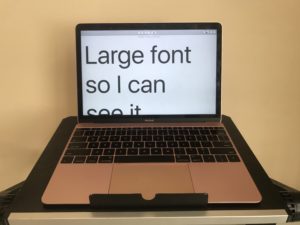(continued from “Navigating Vision Loss in the Workplace” (Part 1) – be sure to read this first!)
In keeping with a blog-length telling of this story I’ll skip the details of the obvious acceptance of the position, the additional HR paperwork and even my first work trip to Northern California (though that most surely will end up as a future post, as several noteworthy challenges presented themselves on the trip, including my Uber getting pulled over on account of me, a pleading conversation with a police officer and some guide dog conundrums)
I was, of course, excited by the flexibility of the new position and how many of the meetings would be done virtually. What I hadn’t accounted for, however, were the many pieces of technology I would need to familiarize myself with in order to conduct these meetings.
When I shadowed my first meeting and saw the experienced support coordinator sharing her computer screen and clicking from resource to resource using her mouse, seamlessly demonstrating extremely visual techniques and interventions, my first thought was “how will I EVER be able to confidently lead an interactive meeting like this?” I doubted my ability to even log in correctly, much less share the proper materials with parents. And my nerves turned to cold sweats when I held a practice meeting with one of my co-workers and mistakenly clicked on my text messages after hitting “share screen,” promptly lighting up my shared screen with all of my personal text messages.
“Um, maybe you don’t have to share your screen during meetings,” she offered. I could tell she was nervous for me.
“Ugh”, I laughed, mortified, “I’ll keep working on it before I do an actual meeting.” And I did. I practiced with my assistive tech trainer. I practiced with my husband. I practiced with imaginary meeting attendants. I came up with techniques to ensure nothing else even appear except the exact document I needed to share, closing every single item on my computer prior to practice meetings (which, if looking at my desktop on any given day, is A LOT of windows!).
Nonetheless, nervous adrenaline pulsed through my entire body as I logged into my first virtual 504 meeting.
The aspect I was most nervous about was how large I had to blow up the accommodations in order to see them well enough to read aloud because it meant that the parent would also have to read a super enlarged version that caused parts of the plan to disappear off the screen. I was also nervous I wouldn’t be able to find it on the desktop or that I would read it in a stammering way, as my fields of vision are so narrow that I really only see one word— and sometimes even one letter— at a time. I went over and over the accommodations in my mind beforehand so that I could paraphrase some of them and not have to read word for word. And when it came time to share my screen, I took my time even though I felt self-conscious about making everyone in the meeting wait in awkward silence as I focused on choosing the correct document. I zoomed in as much as possible, just to glance over a couple of the words, and then paraphrased each accommodation as the parent read along.
 I have been leading these meetings for the past month, and I have moments where I think “holy cow, I’m doing it!” I’m sharing my screen, moving seamlessly through Google Docs, and using technology in ways that felt impossible a couple months ago.
I have been leading these meetings for the past month, and I have moments where I think “holy cow, I’m doing it!” I’m sharing my screen, moving seamlessly through Google Docs, and using technology in ways that felt impossible a couple months ago.
And I’m allowing myself to celebrate those moments of success, something I really didn’t take the time to do in my early working years. I honestly don’t think I was even aware of the beautiful ways I developed to compensate for vision loss in the workplace in my 20s. I felt ashamed of doing things differently, of using non-visual techniques and of admitting that I needed accommodations. I didn’t like to admit that most tasks take me longer. It sometimes feels embarrassing to celebrate acquiring new skills that seem very simple to others. But I think it’s absolutely essential to acknowledge small victories, as they bring awareness to growth. When we don’t recognize growth, we can begin to feel like we are forever striving but never really getting anywhere because there is so much to learn.
To be continued next week..

Joy, you truly are amazing! Not just that you took on this job and are doing it well but also for how wise you are at such a young age! And yes 40 is young!! 😍
I have to say it took me until the last 10 years or so to acknowledge my limitations in life and celebrate myself for who I am. Keep these awesome blogs coming, I love reading your work and I love you! ❤️
I’m in suspense until the next one comes out, lol.
Joy, thank you for your wisdom and courage!
“But I think it’s absolutely essential to acknowledge small victories, as they bring awareness to growth. When we don’t recognize growth, we can begin to feel like we are forever striving but never really getting anywhere because there is so much to learn.”
Just For Today, I will celebrate my small victories and recognize my growth in my life.
Hugs,
Kevin Kuhn